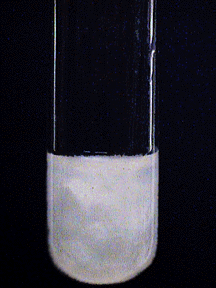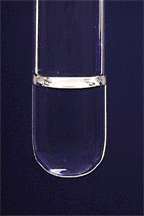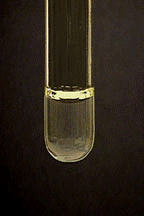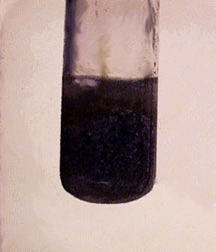Characteristic Reactions of Bismuth (Bi³⁺)
- Page ID
- 97264
- Most common oxidation states: +3, +5
- M.P. 271º
- B.P. 1560º
- Density 9.75 g/cm3
- Characteristics: Bismuth is hard and brittle, with a reddish cast. Rather inactive, but will dissolve in nitric acid or hot sulfuric acid.
Characteristic reactions of Bi³⁺
The +3 oxidation state is the more stable one.
Aqueous Ammonia
Aqueous ammonia reacts with bismuth(III) ion to precipitate white bismuth hydroxide:
\[\ce{Bi^{3+}(aq) + 3NH3(aq) + 3H2O(aq) <=> Bi(OH)3(s) + 3NH4^{+}(aq) } \nonumber \]

Sodium Hydroxide
Sodium hydroxide reacts with bismuth(III) ion to produce a precipitate of Bi(OH)3.
\[\ce{Bi^{3+}(aq) + 3OH^{-}(aq) <=> Bi(OH)3(s)} \nonumber \]

Bi(OH)3 does not dissolve in excess ammonia or sodium hydroxide, but does dissolve in acids:
\[\ce{Bi(OH)3(s) + 3H^{+}(aq) <=> Bi^{3+}(aq) + 3H2O(l)} \nonumber \]

Water
Compounds of \(\ce{Bi^{3+}}\) hydrolyze readily in dilute solutions, especially when chloride ion is present, to form a white precipitate of \(\ce{BiOCl}\):
\[\ce{Bi^{3+}(aq) + Cl^{-}(aq) + H2O(l) <=> BiOCl(s) + 2H^{+}(aq)} \nonumber \]

An acid should be added to aqueous solutions of bismuth(III) salts to prevent this precipitation.
Stannite Ion
Stannite ion reduces bismuth hydroxide to small black particles of metallic bismuth:
\[\ce{2Bi(OH)3(s) + 3Sn(OH)4^{2-}(aq) <=> 2Bi(s) + 3Sn(OH)6^{2-}(aq)} \nonumber \]

The solution of stannite ion must be prepared just prior to use, by treating a solution of tin(II) chloride with excess sodium hydroxide:
\[\ce{Sn^{2+}(aq) + 2OH^{-}(aq) <=> Sn(OH)2(s) (white)} \nonumber \]
\[\ce{Sn(OH)2(s) + 2OH^{-}(aq) <=> Sn(OH)4^{2-}(aq) } \nonumber \]
No Reaction
\(\ce{Cl^{-}}\), \(\ce{SO4^{2-}}\)


